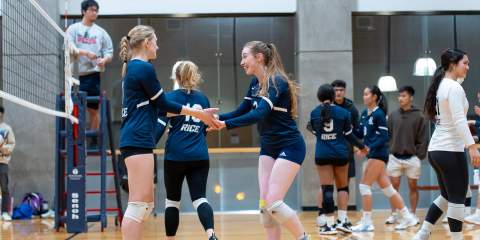I’m Zack, a junior from Jones College pursuing a BA in Computational and Applied Mathematics in the George R. Brown School of Engineering and Computing, and a BS in Mathematics in the Weiss School of Natural Sciences. I still don’t exactly know what I want to do after graduation, but I think that having the ability to create mathematical models will equip me well for many different areas of life. In addition to studying math, I also plan on completing a minor in creative writing. Adequate writing skills are pertinent to any degree, and math, as you can imagine, gets rather intense at times. I am also active in several other communities at Rice: I am captain of the men’s club volleyball team; I am chief justice of my college; and I DJ at KTRU.


Computational and Applied Mathematics (CAAM) is one of the smaller STEM degrees at Rice as only a dozen or two students pursue it each year. A lot of the enrollment in core CAAM classes actually comes from students in other areas of study taking degree requirements or electives. But the breadth of topics offered through CAAM is what made these classes super interesting to me. Currently, I am taking Modelling Mathematical Physics, and many people in this class are studying physics or mechanical engineering — getting to take this class exposes me to the intuition that drives their fields. Some other classes that I am taking, Graph Theory and Numerical Analysis, are populated with people from a number of different computational sciences. These classes teach vital computer algorithms that guide many of the fundamental processes of function solvers. The last class I am registered for this semester, Partial Differential Equations, forms a basis for a lot of computational mathematics, but all the intuition is imported in a pure math setting in conjunction with the math department.
Something else that has been just as formative for my experience in this degree has been the research I’ve conducted. I actually wasn’t too active in research until this year. During my sophomore year, I worked in an ecology lab and did a little bit of independent exploring outside of that. Now, I have two research positions, one at Baylor College of Medicine and one in the CMOR department. The former, I started over the summer in the computational biology department at Baylor. It involves cell segmentation, which means it is not as math-heavy as, say, my classes. However, being an applied math major means that I am able to understand a lot of the machine learning that our cell tomography will eventually contribute to.


Next semester, I hope to take Computational Biology and Neural Computation, which are both cross-listed with other departments and facilitate an interdisciplinary study of both biology and neuroscience. One of the most popular classes in the CMOR department is Introduction to Operations Research. This class is not taught in a traditional lecture format and challenges students — many from backgrounds like business and economics — to solve optimization problems in a small group setting. I took this class during my first semester at Rice, and it has played a huge role in why I am still part of the CAAM department today!
The other research that I do is very different. I work with Professor Beatrice Riviere, a CAAM professor with an incredible background in solving PDEs. Currently, I am working on a piece of code that combines two different methods for solving what is known as Incompressible Two-Phase Flow. This equation is useful in describing how two different fluids interact. It is incredible to see how these very complicated methods can be implemented to solve real-world problems. It is also such a privilege to work so closely with Professor Riviere, who has significantly contributed to this field.

One last thing that I think is important to mention about the CAAM degree is that it is relatively short to complete compared to other engineering degrees. This means many individuals in the department choose to add on another major or explore other classes. Others choose to take that time to explore different areas of research or find other leadership opportunities in clubs, the college system, or student businesses. I have been lucky enough to do all these things thanks to how the CAAM degree is set up. It can be easy to regret or rethink your major almost religiously in college, but I have few doubts that this degree is exactly where I should be.
-Zack, Jones ‘26 (Published on 11/14/24)
Keep Exploring
The college application journey can often feel like navigating a complex maze. As a Master of Accounting student at the Jones Graduate School of Business who completed the application process for both her undergraduate and graduate degrees, Yamila understands the stress and pressure that come with planning for your future. Below, she shares her best advice for practicing self-care and finding balance along the way.
What is the secret to doing it all? Karlianna, Duncan ‘28, a Biochemistry (BS) and Psychology (BA) major, offers her practical, proven strategies for managing her packed schedule — and still finding time to thrive — at Rice.
What began as a three-month Loewenstern Fellowship quickly became a lifelong commitment to fighting food insecurity. Read how a return trip to Bolivia affirmed the lasting power of global service for Neha, Lovett '26.
Helpful Links
713-348-7423
admission@rice.edu
M-F 8:30 a.m. to 5 p.m. CT


